展覧会についてExhibition
This exhibition presents the development of Korean abstract painting through the works of 19 artists. In South Korea, during the period of Japanese occupation and during the chaos of conflict between ideologies in the post-World War II era, artists had difficulties in accomplishing even the basic art process of creating and displaying their works. We can imagine how there was firm resolve amongst these artists to develop Korean art as a form of national identity in the face of influence from Japan and other countries.
The paths of Korean abstract painting were carved out independently by individual artists working in such situations, and thus it is hard to define them as a coherent flow. However, if we were to group the artists displayed here by their characteristics, then Kim Whanki, Quac In-Sik, and Lee Se-Duk were artists educated in the pre-war era, when Korea was under Japanese rule. They then traveled to Japan and the West where they positioned themselves within the abstract art movements of the period. Then there were those who trained as artists under the new post-war system, and were influenced by Western art of the period, such as Informel, and later created the monochrome paintings that can be considered distinctively Korean abstract art. These artists include Kwon Young-Woo, Chung Chang-Sup, Yun Hyong-Keun, Park Seo-Bo, Chung Sang-Hwa, Ha Chong-Hyun and Lee U-Fan. These second generation artists are now joined by artists have taken up the spirit of their predecessors to become the third generation of this progression, leading the Korean art world today.
While this exhibition cannot display the totality of Korea’s rich abstract expression, we hope that visitors to the exhibition will enjoy this opportunity to see one part of Korea’s unique abstract painting, artwork that is characterised by the serene, refined air acquired by these artists as they overcame difficulties and struggles.
-
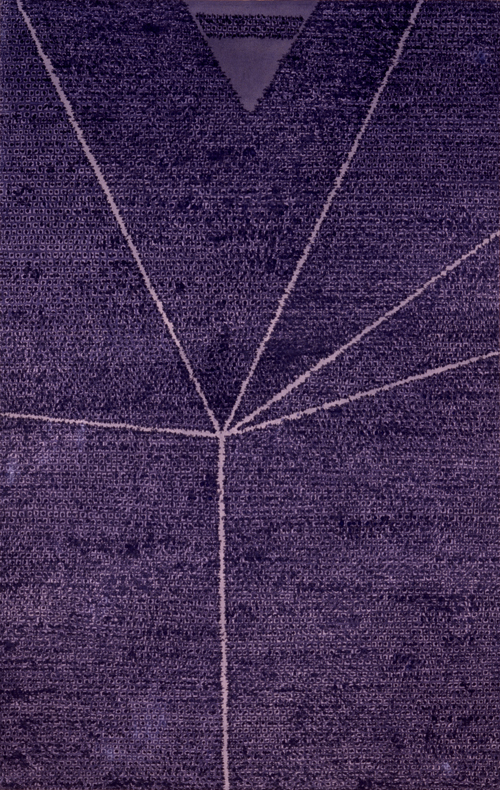
-
KIM Whanki
Work 20-V-74
1974
oil on canvas
264.5 x 167.8cm
Fukuoka Asian Art Museum
© Whanki Foundation/Whanki MuseumKim was born on an island in the East China Sea off the southwest coast of the Korean Peninsula. Like many of the aspiring young Korean artists of the day, he traveled to Japan to study Western-style painting. He participated in the Free Artists’ Association, established in Japan soon after his return to Korea in 1937, and continued to exhibit works in Japan. Kim’s works from around this period present Korean objects as motifs in abstracted landscapes and geometrically deformed still lifes, with his relatively lushly brushed works exuding a lyrical mood.
After World War II, Kim became a professor at a Korean art university, where he mentored the following generation, including Yun Hyong-Keun, who was at the time his student and later became his son-in-law. Amidst his growing renown in South Korea, in 1956 he traveled to France, spending four years there, displaying his works throughout Europe. In 1963, he was one of the Korean representatives at the 7th Bienal de São Paolo. The following year he moved to New York, which remained his base for the rest of his life.
Kim trained in Western painting in Japan and then positioned himself in the midst of the Western abstract movement. He created this work in the dot painting technique, a method he arrived at with the aim of creating a uniquely Korean form of abstract painting. He applied dots of thinned blue oil pigment across the entire canvas and circled them with lines, in a production method that can be called a means of seeking the truth. The composition thus simultaneously reveals both intimate detail and universal expanse.
-
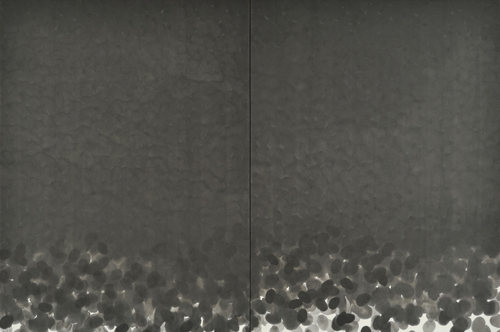
-
QUAC In-Sik
Work 86-KK
1986
Chinese ink on Japanese paper
199.0 x 300.0cm
Tokyo Opera City Art Gallery
photo: SAITO Arata -
Quac arrived in Japan in 1937 to study at an art school, and made Japan his primary base of operations for the rest of his life. While at first he created three-dimensional works from glass and stone, he turned to painting in ink on Japanese paper around the early 1970s.
We can likely say that ink was a fundamental material for Quac. Born into a merchant family in Daegu, during his childhood he learned about calligraphy and ink painting of the past from the adults around him. In summer, he would take his inkpot, brush and rice ball lunch and go to the nearby river fields. There he would find a large flat rock and he would paint directly on its surface. He would wash off the painting with water from the river, and then start again. He was enthralled by this play, spending all day lost in his dreams.
The cocoon-like dots painted on Japanese paper, like river rocks, each have their own shape, none are the same. At the same time, they are a presence that symbolises “something that is at once something, and nothing”. Accepting this dualistic way of being, or indeed seeking it out, he shared this belief that such constituted a painting with the monochrome painting artists of the following generations. Paint one, let it dry, paint the next, let it dry. This repeated layering of dots mesmerises viewers, who within that structure see a space that is at once depth-filled and floating. Such translucent layering reveals an understanding of the characteristics of the material ink. Quac’s works can be said to exude the sound of forms born, and the birth of forms to come.
-
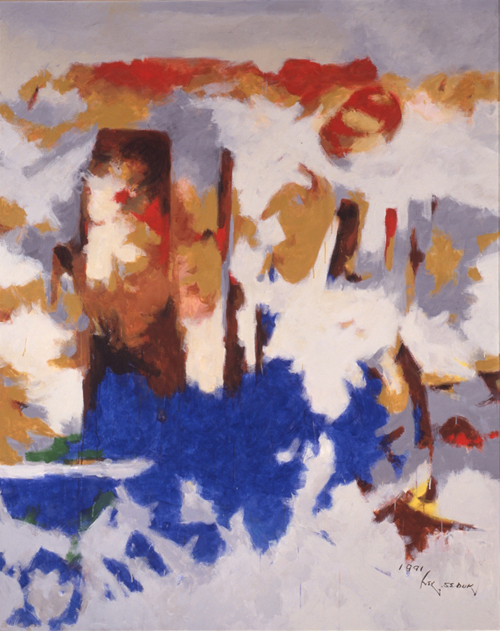
-
LEE Se-Duk
Cherished Image
1991
oil on canvas
227.0 x 182.0cm
Shimonoseki City Art MuseumBorn in Seoul, Lee studied Western-style painting in Japan from 1940 to 1944. He travelled to Europe in the 1950s and spent time in Paris during the height of the Informel movement. He was thus one of the few Korean artists who was able to experience the Informel activities first-hand.
Moving in tandem with 20th century modernism, Lee’s work shifted from the representational to the non-representational to the abstract as he aimed for a fusion of Western aesthetics and Korean traditions. His early period paintings depict Korean traditional motifs in representational form, and eventually he shifted to abstract works based on the five essential colours of Korea, namely a base tone of off-white or grey combined with the red, yellow, blue and black. In these works, he created a lyric realm that balanced sentiment and intellect.
Lee, conversant with circumstances in Japan and Europe, played a role in conveying the movements of each country to artists in Korea. This meant that many Korean artists had their first contact with Informel via Lee. Active as an artist, exhibition planner and exhibition artist selector, Lee made valuable contributions to critiquing and advancement of the art of his period.
-
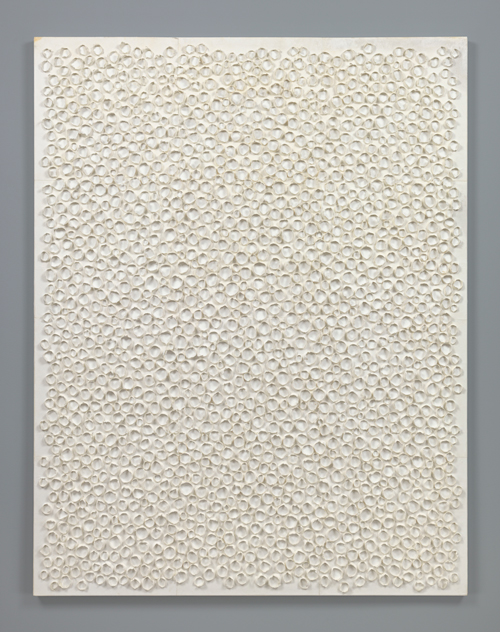
-
KWON Young-Woo
Untitled
1982
Korean paper
157.0 x 122.0cm
Private collection, Seattle
Courtesy of the artist and Blum & Poe, Los Angeles/New York/TokyoKwon specialised in Asian painting while in university. His attendance at Western-style painting classes as a student and other experimental activities characterised his early period. His highly abstracted ink paintings, with subjects boldly omitted, received honourable mentions in Korea’s National Exhibition in 1959. He went on to be a judge for that competition and was active as a member of the Korean painting world. Kwon also briefly participated in Mungminhoe (the Ink Forest Group), an avant-garde ink painting society founded by his classmate Suh Se-Ok.
Advancing a stage beyond ink painting created with the simple materials of ink and paper, Kwon confronted the material of paper itself. In his solo exhibition held in Seoul in 1966, he cut holes in paintings, pasted on other bits, pushed through from the back surface, all works composed without the use of ink. In 1975, he was one of the artists included in the early exhibition considering the monochrome in Korean abstract painting, Korea: Five Artists, Five Hinsek (White), Tokyo Gallery, thus expanding his display locations to Japan.
Kwon’s paintings, not dependent on colour, create through light and shadow, challenging the ground/image painting construct itself. His works can be seen as a fusion of the artist’s act, using his hands to elevate the materials’ internal powers, with a spirit based on the East Asian view of nature that accepts things as is.
-
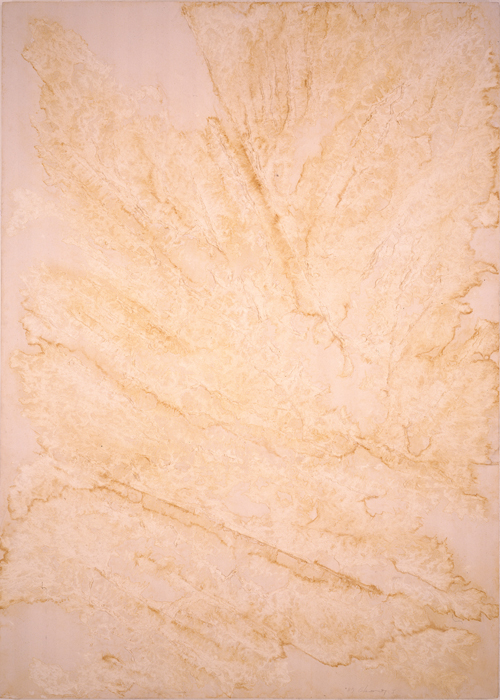
-
CHUNG Chang-Sup
Tak No.87015
1987
mixed media with tak fiber on cotton
227.8 x 162.2cm
Hiroshima City Museum of Contemporary ArtChung studied Western-style painting, and in his early period produced abstract paintings influenced by Informel, an important postwar art style. In the 1970s he turned to creating works in which he pasted traditional Korean paper onto canvas. Korean paper then remained an important material in his works over the next forty years until his death.
In the 1980s, he began his Tak series, which represented one aspect of the development of monochrome paintings, and then in the 1990s he created his Meditation series. All of these works involved soaking Korean paper in water, separating their fibres, and then spreading those fibres onto the canvas and fixing them there. Korean paper, like Japanese paper, is used not only for writing and painting, but for such everyday purposes as paper screen doors. Thus, it is a material indispensable to Korean traditional lifestyles. Through this mulberry bark paper – both part of everyday life and symbolic of the Korean people -- Chung aimed for unification of the thing and the self, a borderland that surpasses intention and act.
“Paint without painting, make without making – basically, that is my hope.” These words in the artist’s notebooks indicate that Chung’s works seek a ground plane that harmonises the spiritual and the material, and indeed, they can be considered the path he took to get there.
-
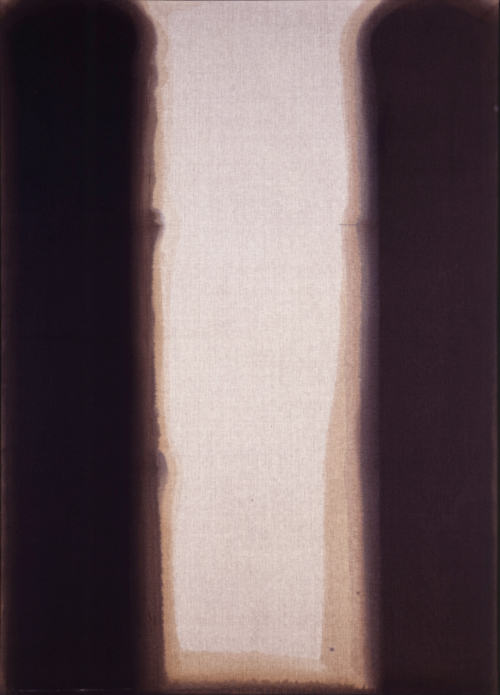
-
YUN Hyong-Keun
Umber-Blue 337-75 #203
1975
oil on linen
251.3 x 181.1cm
Fukuoka Asian Art MuseumWhile the second half of the 20th century Korea was both a turbulent time and a difficult environment for many artists, the first half of Yun’s life was even more challenging still. The Korean War broke out while he was a student in the Art Department of Seoul University, and his studies were interrupted by imprisonment for anti-establishment activities. Through the help of Kim Whanki, who would later become his father-in-law, he was able to enter Hongik University, where Kim taught, in 1959, restarting his education interrupted more than seven years prior.
He first displayed a work titled Umber-Blue in 1973, and as its title implies, it is painted in deep brown and blue pigments. Yun used these colours throughout his life, saying that they encapsulate the places where all things exist, they are the colours of the earth, sky and water. While his early period works included numerous vertical lines, they gradually joined into thick lines, and then planes. The thin, watered down pigments soak into the canvas prepared with almost no ground layers. As if to erase traces of the artist’s hand, their spreading across the picture plane reveals a sense of the artist’s unwavering will, seeking the roots of painting.
While debuting late as an artist, Yun’s works were immediately recognised, and he became one of the artists displaying works in many of the important exhibitions raising international awareness of monochrome painting. In Japan, he displayed works in the Korea: Facet of Contemporary Art (Tokyo Central Museum of Art) exhibition in 1977, and held solo shows at Muramatsu Gallery and Tokyo Gallery, two galleries who were early introducers of Korean abstract art.
-
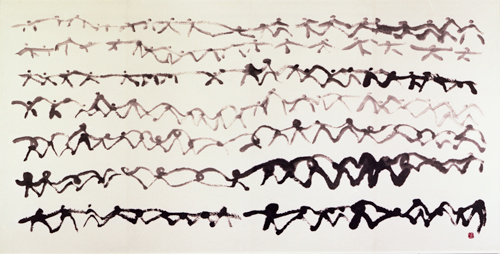
-
SUH Se-Ok
Group Dance
1979
Chinese ink on paper
143.5 x 282.4cm
Fukuoka Asian Art Museum -
After World War II, Suh focused on Asian painting at university and sought a new form of painting unbound by traditions. He remains today an artist who has continued to always use ink as his medium. He became a teacher at the university he graduated from, and Lee U-Fan was one of his students. Today Suh’s son Suh Do-Ho is a contemporary artist active internationally.
Suh established the avant-garde society Mungminhoe (the Ink Forest Group) in 1959 and was a leading presence in the movement to establish a new ground plane in East Asian painting. Most Western-style Korean painters learned about Western art through either time in Japan or direct contact in the West, and took those opportunities to seek out a uniquely Korean form of expression. Conversely, ink painting artists such as Suh believed in the revolution from within themselves. They also sought how to attain a sense of their own times in East Asian painting, a medium positioned outside contemporary art, while at the same time considered how to return to the true nature of East Asian painting. Thus, there were battles between these two challenges in Suh’s pursuits and accomplishments.
Countless figures dancing with hands joined appear in Group Dancing, and from the 1970s onwards Suh repeatedly depicted the human form. Suh’s works appear as both paintings and calligraphy, and his free brush strokes – based on both the East Asian context with its lettering sourced from representational forms, and the literati tradition – sink deeply, quietly into the hearts of their viewers.
-
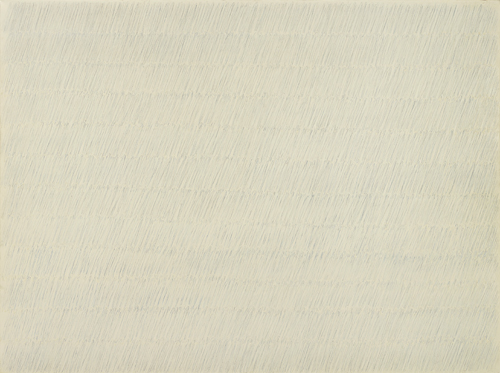
-
PARK Seo-Bo
Ecriture No.27-77
1977
oil and pencil on canvas
194.4 x 259.9cm
Fukuoka Asian Art Museum -
Park was one of the central figures in the 1970s development of Korean monochrome painting, what we now call Dansaekhwa. Receiving his art education in the post-war era and spending his youth in the confusion of the Korean War years, Park was a spearhead figure in Korean avant-garde, one who absorbed influence from Informel face on, while also establishing the Modern Artists’ Association that opposed the authority and traditions of the painting circles of the day.
In 1967, he began his Ecriture series, a title that would then continue throughout his work. After coating the canvas with white oil pigment, he would touch swift pencil strokes into the still drying paint. The rhythmical, repeated strokes were like imprints upon the canvas. In this selfless repetition that evokes a monk’s religious practices or indeed, human breath itself, Park empties himself, leading him towards liberation from the act known as expression. Works created in this method were included in the 1975 exhibition, Korea: Five Artists, Five Hinsek (White) and drew high praise both in Korea and overseas as a uniquely Korean form of spiritually contemporary art that appealed to the mind. From the 1980s onwards he broke new ground with a series of works that layer canvas with Korean paper and pigments, and use fingers and sticks to make indentions in the resulting surface.
Frequently selected as an exhibiting artist at international biennale and triennale exhibitions, Park contributed to the overseas recognition of Korean contemporary art. As a member of art exhibition judging committees he also helped send Korean artists out onto the international stage.
-
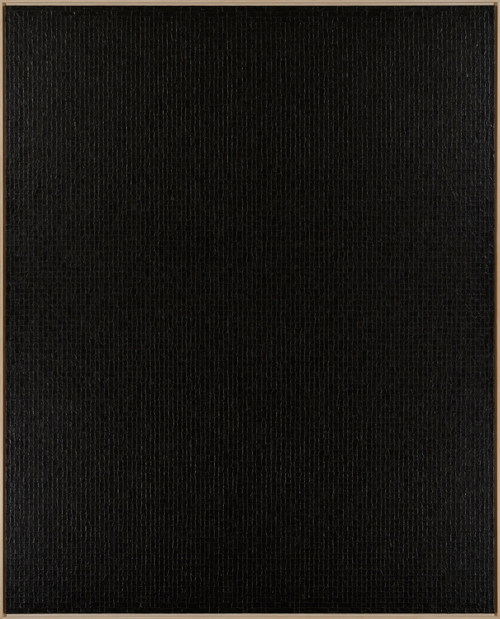
-
CHUNG Sang-Hwa
Untitled 91-3-9
1991
acrylic on canvas
162.0 x 130.0cm
Tokyo Opera City Art Gallery
photo: HAYAKAWA KoichiThe majority of Dansaekhwa artists worked in Korea, and then broadcast their ideas to Japan and the world. Conversely, Chung is one of its important artists who works overseas. After graduating from university in Korea, Chung travelled to Paris in 1967, and then in 1969 moved to Kobe, Japan. In 1977, he set out again for Paris, living overseas for a long period until his return to Korea in 1990.
Like the other Dansaekhwa artists, Chung’s early works were polychrome abstract paintings influenced by the Informel movement. With the arrival of the 1970s, the colour disappeared and he began to create the work style that became a synonym for this artist, namely imbedding only white pigment into grids on the painting surface. This painting was created by this unique method. After coating the entire canvas surface with paint, he would remove the canvas from the stretchers as the pigment dried, and create cracks in the pigment by folding along pencil-drawn lines on the back of the canvas. Spreading out the canvas again, stretching it on the stretchers, he would then peel the pigment from the cracked areas before filling them with pigment again, repeating this peeling and filling process over and over again. He then created works in this style using colourless black or the traditional Korean colour blue. These canvases that took massive amounts of time and effort to create, use the repetitive process characteristic of monochrome paintings to create a spiritually tinged, noble visual experience.
-
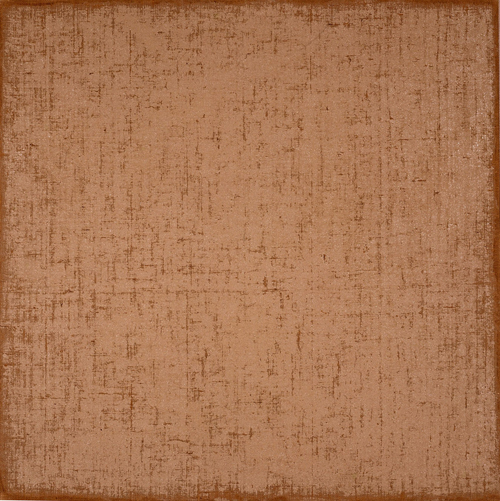
-
HA Chong-Hyun
Conjunction 84-2
1984
oil on hemp
120.0 x 120.0cm
Mie Prefectural Art MuseumHa studied Western-style painting and in his early period worked within the flow of Informel and geometric abstraction. Then his interest turned towards material quality and its relativity, creating three-dimensional works and installations that closely harmonised with those of the Japanese Mono-ha artists of the same period. During this period, he led A.G. (Avant Garde), a short-lived avant-garde group that nonetheless was influential in the Korean art world.
Ha displayed his first work using the Conjunction title in 1974. Applying great force, he pushed oil pigments into the back of roughly woven linen, with the pigments pushing through the cloth weave to appear on the front surface. This unique method not only disrupts the relationship between support material and medium, planar and three dimensional, it also reconsiders the relationship between expression and non-expression.
Ha’s works titled Conjunction not only show the indivisible unification of the paint and linen materials, they also make us question the premise of the subjective/objective duality of things/objects. Perhaps they can also be said to display the Asian duality of contradiction/opposition with reception/fusion.
-
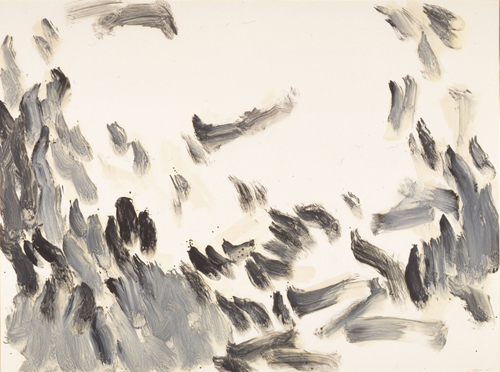
-
LEE U-Fan
With Winds
1989
mineral pigment, oil on canvas
194.2 x 245.0cm
Tokyo Opera City Art Gallery
photo: SAITO ArataLee was a mainstay of the Mono-ha movement of the 1960s through mid-1970s, and was also a major artist in 1970s Korean monochrome painting. Lee is also known for his central role in introducing Korean artists to Japan.
After one year in the Art Department of Seoul National University, Lee moved to Japan and transferred to the Department of Philosophy at Nihon University. Using Japan as his base from then on, he has played a leading role in art world interchange between the two countries. In addition to his artistic production, Lee also wrote articles about Japanese art trends for Korean magazines, and these articles became an important information source for Korean artists. In 1968, Lee’s work was included in the Korean Contemporary Painting exhibition held at the National Museum of Modern Art, Tokyo, the first full scale exhibition of Korean contemporary art held in Japan in the postwar era. He also became acquainted with Park Seo-Bo, another artist included in the exhibition.
In 1973, he displayed his From Point and From Line series at Tokyo Gallery. As if returning to the calligraphy practice he continued throughout his childhood in Korea, he repeatedly moved his pigment-loaded brush, with each blur-accompanied dot or line left as imprint of his second-by-second movements. In his 1980s series From Winds and With Winds, Lee shifted to more generous strokes, with an irregular rhythm to their repetition, thus creating a dynamic space through the back and forth between blank canvas and stroke.
-
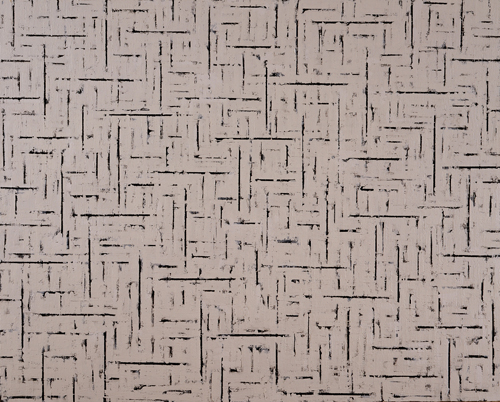
-
CHOI Myoung-Young
Conditional Plane 99115
1999
oil on canvas
182.0 x 227.0cm
Mie Prefectural Art Museum -
After graduating from university in 1964, Choi was selected for participation in large-scale exhibitions held both in Korea and overseas, and thus became noticed relatively early in his career. In the 1970s, he returned to university to study for a master’s degree, while at the same time creating a series titled White in which he directly addressed the concept of a single colour. In the latter half of the 1970s, he created his Conditional Plane Surface series. In his early period works he would coat the entire canvas surface with white pigment, and then before the pigment dried, he would gently brush it to scuff the surface, to give detailed texture to the pigment and thus create an ascetic painting surface similar to a porcelain or ceramic surface feel. The works of this period were introduced to Japan in the exhibition The Latter Half of the 70’s: An Aspect (Tokyo Metropolitan Art Museum).
In the 1980s, black vertical and horizontal lines appeared on his paintings. These lines were not drawn onto the white pigment ground. Rather, first he would paint the entire canvas black, then he would layer on repeated brush strokes of white, with the black lines appearing as negative space. Choi’s restrained canvases, made up solely of white and black geometric patterns, encapsulate the dramatic aspects of the revolutions of light and dark, existing as quietly expansive flat surfaces.
-
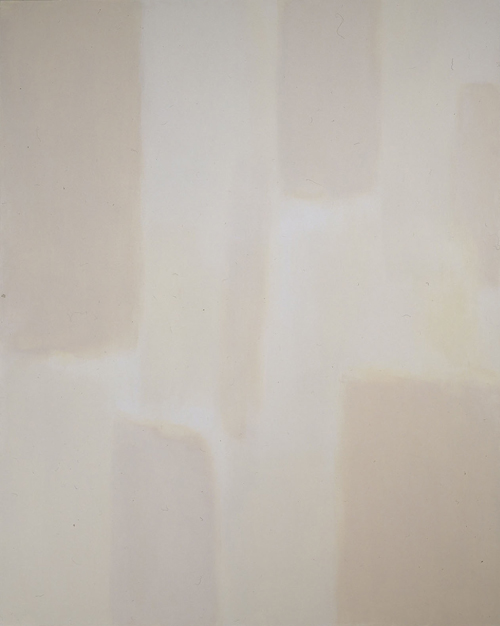
-
SUH Seung-Won
Simultaneity 99-828
1999
acrylic on canvas
228.0 x 182.0cm
Mie Prefectural Art MuseumSuh graduated from university in 1964, participated in the avant-garde group A.G. (Avant Garde) after its founding in 1969, and was active as a member until its disbanding in 1974. Like Choi Myoung-Young, a noteworthy early activity was the introduction he received in the 1975 exhibition titled Korea: Five Artists, Five Hinsek (White). The work from this period, which had already gained the Simultaneity title, has a decomposed geometric, three-dimensional form, reminiscent of an axiomatic architectural drawing, set against the white picture plane. These works are equipped with a distinctive intellectual rigour that distinguishes them from those displayed by the older artists Kwon Young-Woo and Park Seo-Bo at the same time, each revealing craft-like handling born from repeated actions.
Suh’s style later changed, and he went through a period of using rough brushstrokes to create geometric forms that filled the canvas. In the latter half of the 1990s, his outlines dissolved and he juxtaposed or overlapped light toned colour planes to arrive at a calm painting surface. Liberated from strict geometry, festive, gentle-light filled painting spaces hint at the world outside the composition as they expand outward from the canvas.
-
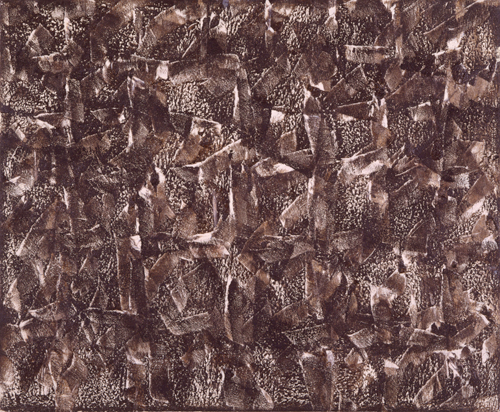
-
LEE Chung-Ji
O-89
1989
oil on canvas
60.4x72.5cm
Fukuoka Asian Art Museum -
Lee finished graduate school at Hongik University in 1968 and then had her first solo exhibition in 1972 at the Shinsegae Gallery, known for having exhibited many earlier monochrome painting artists.
With the arrival of the 1980s, more opportunities arose for display in Japan. In addition to solo exhibitions at Muramatsu Gallery in 1983 and 1985, her works were also included in the 2nd Asian Art Show, Fukuoka, held at the Fukuoka Art Museum in 1986 and the Muramatsu Gallery group exhibition featuring Japanese and Korean female artists.
Lee’s works exhibited here all date from the latter half of the 1980s, featuring a subdued palette that continues the monochrome legacy in Korean abstract painting and the use of repetitive brushstrokes to construct the composition. Those strokes move rhythmically, regularly, to directly divide up the picture plane, in the end producing a distinctive canvas that breaks control amidst the rhythm.
-
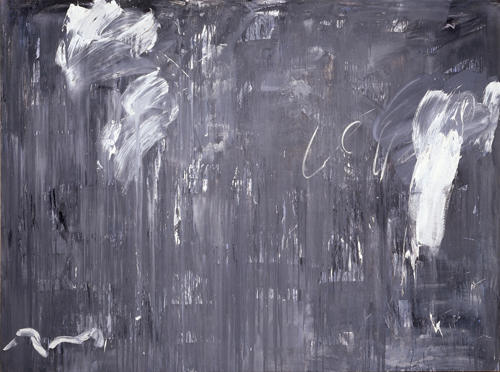
-
LEE Kang-So
Untitled - 93009
1993
oil on canvas
194.0 x 260.0cm
Mie Prefectural Art Museum -
Lee Kang-So first worked on installations made up of three-dimensional elements or performances at the beginning of his artistic activities. In 1973 his first solo exhibition at the Myongdong Gallery featured the setup of a tavern inside the gallery, while at the 1975 Paris Biennale he set a chicken in the venue to create a work. These and other works led to Lee being known as an avant-garde conceptual artist. From 1971 to 1973 Lee also participated in the A. G. (Avant Garde) group.
Once Lee began working in painting, he always produced works with broad brushstrokes and a sense of movement. Deer, duck and boat motifs appear in his 1980s works, but gradually those forms disappeared as he shifted to purely abstract painting.
From the early period three-dimensional works through to the present-day abstract paintings, Lee’s works all share an inner sense of time and the duality of finished/unfinished. The calligraphy-like brushstrokes in his paintings reveal the trace of the brush’s movement, and those canvases show one part of some movement in this world. They seemingly anticipate the possible addition of a different line or dot at any moment, being at once finished and unfinished, but they also retain the characteristics of an independent work.
-
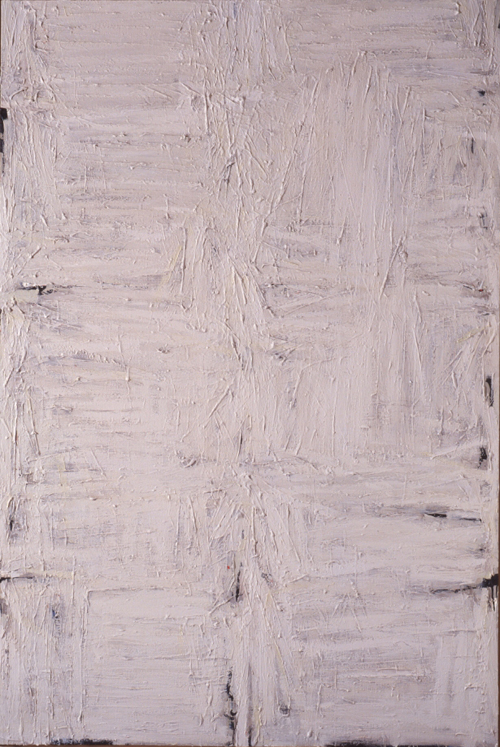
-
KIM Tae-Ho
Form 91-902
1991
acrylic on canvas
193.0 x 130.0cm
Shimonoseki City Art MuseumKim Tae-Ho was active from a young age, winning various prizes while still a university student. At first he used spray paint to create geometrical abstract paintings on a smooth surface, but then he turned to a period of creating woodcuts. At the end of the 1980s he began to attach sections of Korean paper to his canvas and then layer pigments on top of them, to create paintings with dense matière. With the beginning of the 1990s, he shifted to works using only set pigments applied as-is in rhythmical brush movements. The work displayed here is from that period.
Kim’s works continued to develop, and today he continues to work on his Internal Rhythm series. In these paintings he covers the entire canvas surface with many layers of pigments, and then uses a knife to “excavate”, scraping away at the surface to reveal the lower level pigments.
With changes in his style through each succeeding period, his works consistently show a focus on the material quality of the painting surface, and the artisan-like techniques used to achieve that surface. Kim’s works with these characteristics reveal an East Asian spirituality born from religious practices, a feature shared with the artists of the previous generation.
-
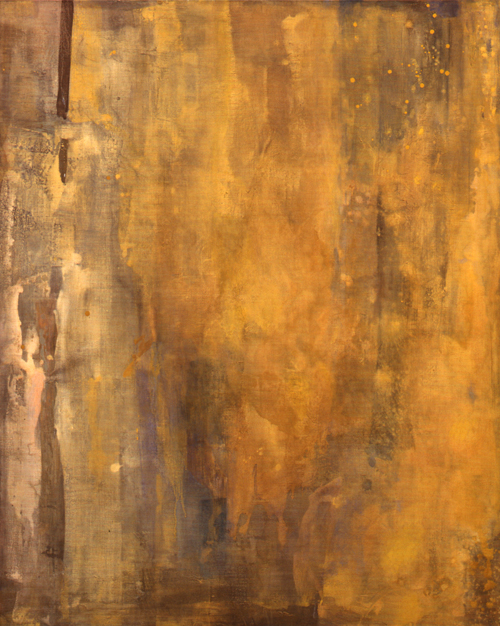
-
CHOI Eun-Kyoung
Beyond the Colours #14
1992
tempera, oil on canvas
162.1 x 130.3cm
Tokyo Opera City Art Gallery
photo: SAITO ArataBorn and raised in Seoul, Choi graduated from a university in Korea and then entered the Technique and Material Course at the National University of Fine Arts and Music (present-day Tokyo University of the Arts) in Tokyo. Choi has continued to base herself in Japan since graduation. After exhibiting in the Women Artists Association exhibitions, Ryoyo-no-me, and the Vision of Contemporary Art exhibitions, in 1997 she travelled to Paris. There she spent several years painting and displaying her works.
Choi’s Beyond the Colours series begun in 1990, as indicated by its title, acquires a breadth and depth into which the viewer wants to leap wholeheartedly and swim amidst the colours. These picture planes with their colours obtained from the earth, water and sky all seem to share a moist atmosphere that is good for human life. Looking closely, you can see the rich texture made up of layering of various techniques, such as puddling, oozing or scraping the pigments. All contribute a sense of quiet movement and spatial feel to the surface.
-
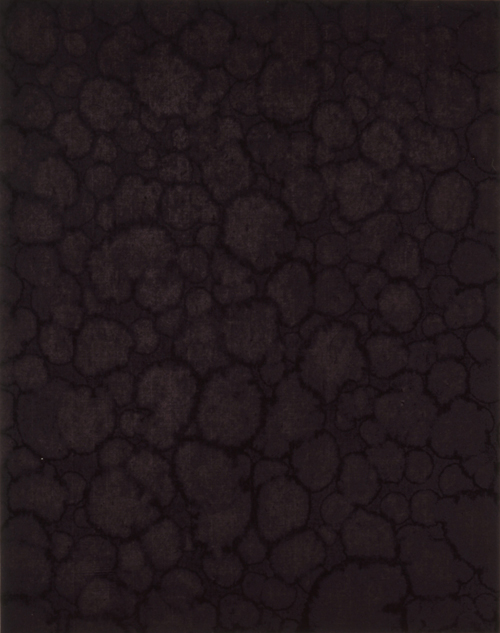
-
LEE In-Hyeon
print on paper - untitled from trompe-l'oeil
1986
lithograph on Japanese paper
64.0 x 50.5cm
Tokyo Opera City Art GalleryAfter graduating from the Art Department of Seoul University in 1980, Lee pursued both a Masters and a Ph.D. at the Tokyo National University of Fine Arts and Music. While a student Lee held solo exhibitions at galleries in Japan. His Nine Mirrors of Painting series was created during this period. These works with deep blue pigment soaking into Japanese paper are reminiscent of the processes used in glazed ceramics and shibori-dyed cloth. Lee’s works are characterised by the grasp of the special features of his materials and their subtle control, and an active inclusion of chance in his process.
Lee began the Epistémè of Painting series in the early 1990s and continues work on them today. The term épistémè is Greek-derived and a philosophical concept heralded by Michel Foucault. This series given that name reveals the artist’s stance of questioning all aspects of the true nature of painting, and here too a restrained blue blurring continually appears. In recent works Lee has continued the colour fields right up to the edge of the sides of the canvas in a thickness unusual for painting. In this manner, and also in other ways, he continues to engage with the problem of the frontality of paintings.
-
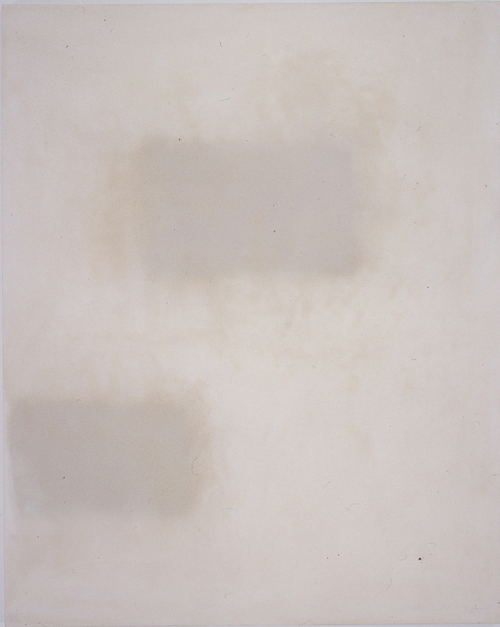
-
YOON Hee-Chang
Something
2000
ceramic powder, glue on panel
163.0 x 130.0cm
Tokyo Opera City Art GalleryYoon was born and raised in Japan and today continues to base his work in Tokyo. In his works he seeks to activate the viewer’s awareness of the connection between the work and the space in which it is placed. Working seamlessly in both planar and three-dimensional forms, throughout Yoon’s works are characterised by their use of soil. In the Something series, he gathers soil and fires it to a high temperature to produce tiny shavings of ceramic material, before then combining shavings with nikawa (animal glue) to make the pigment for his painting. These works continue on the theme found in his preceding Stand it By series, “going and coming effortlessly between existence and nothingness”.
In his pale coloured canvases that invariably appear taciturn, the imagery’s appearance changes as the natural light shining in from a window shifts, surprising with an unexpected loquacity. The recent Sand River Works series uses sand gathered from rivers as its material. The special sand quality, blended from different sand types gathered at upstream locations and carried across national borders and other boundaries, can be linked to our own personal culture that we create from the formation of the cities we live in, the resulting shifting gathering of people, things and information. By selecting soil and sand, two things we can easily forget as everyday items outside our awareness, the careful selection and making use of these things as art materials reveals the potential found in the as yet unseen true nature of the everyday things around us.


















